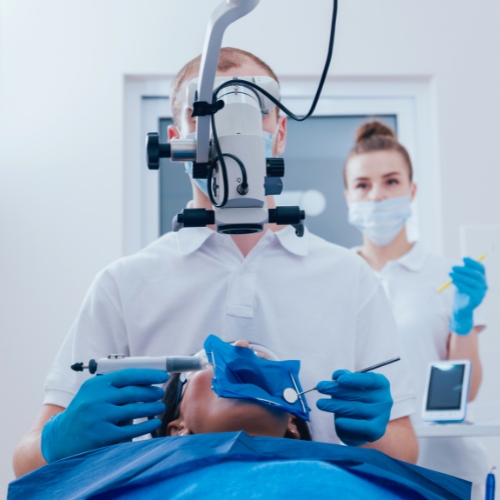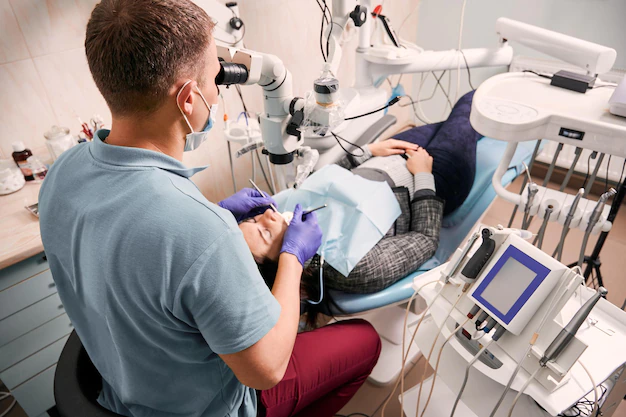Microscopic Dentist In Hyderabad
Safe & Secure | Experienced Doctors | Well Trained Staff

What Is Microscopic Dentistry?
Microscopic dentistry is a field of dentistry that utilises high-powered magnification and specialised equipment to improve the precision and accuracy of dental procedures. This approach allows dentists to identify and treat small, hard-to-see problems in the mouth, such as decay in tiny crevices or cracks in teeth, that may be missed with traditional methods.
One of the key tools used in microscopic dentistry is the dental microscope. This device uses powerful magnification and specialised lighting to provide a highly detailed view of the teeth and surrounding structures. The use of a microscope in dentistry allows practitioners to observe details that would otherwise be invisible to the unaided eye, such as minuscule cracks or fissures in teeth, early stages of decay, or damage to the roots of teeth.
Another important tool used in microscopic dentistry is the surgical operating microscope. This device is used during procedures such as root canals, laser dentistry, extractions, and implant surgery to provide a highly magnified view of the tooth or jawbone. This allows dentists to see the intricate anatomy of the tooth or jaw and to make precise incisions and movements, reducing the risk of complications and improving the outcome of the procedure.
About Microscopic Dentist in Hyderabad
Hyderabad Laser Dentistry sets itself one step ahead of other dental care providers in Hyderabad by utilising microscopes during dental procedures. This allows the dentists to have a wide and clear view of the affected area or area where the treatment has to be done. Dr. D. Rajasekhar, the first official biological dentist of India who is also the head at Hyderabad Laser Dentistry has himself said that “microscopic dentistry helps to have an enhanced level of vision and precision, resulting in better treatment outcomes for patients.”
This method of practice is not common among dentists and is considered to be a high-level technique only used by top-tier professionals. Using microscopes during examining also allows scope for more accurate diagnosis and greater patient confidence in their dentist and their treatment plan.
Procedures Done With Microscopic Dentistry
The use of dental microscopes and surgical operating microscopes provides a highly detailed view of the teeth and surrounding structures, which allows dentists to see fine details that would be difficult or impossible to detect with the naked eye.
Depending on the procedure, the dentist may use specialised instruments and techniques to access and treat the problem area.
Some common procedures that may be performed using microscopic dentistry include:
1) Root Canal
2) Extractions
3) Implant Surgery
4) Restorative Procedures
5) Laser Treatment
6) Periodontal Procedures
7) Endodontic Therapy
8) Microsurgery
9) Diagnosis
10) Cosmetic Dentistry
Benefits Of Microscopic Dentistry
Microscopic Dentistry, though is a very old practice but is gaining popularity nowadays, because of its long list of benefits. Here are the benefits of microscopic dentistry listed below:
-
Enhances The View
Magnification provided by the microscope, which ranges from 3X to 30X, can be easily adjusted and offers a deeper depth of field view and wider field of view than traditional dental equipment.
-
More Effective Periodontal Treatment
The use of Microscopic Dentistry can help to detect and treat periodontal diseases and conditions more effectively.
-
Increased Precision And Accuracy
Dentists are able to reach and examine small, confined areas of the tooth, such as narrow canal openings, without having to remove unnecessary tooth structure.
-
Risk Mitigation
By using microscopy to identify and treat small problems early, before they become more severe, dentists can reduce the ‘guesswork’ and risk of complications during dentistry procedures.
-
Improved Ergonomics
Recent studies have shown that over 75% of dentists who use dental surgical microscopes have reported improved ergonomics in their practice.
-
High Success Rate
The use of a microscope allows the dentist to see the anatomy of the tooth or jaw more clearly, which results in a higher success rate for these procedures.
-
Enhanced Patient Satisfaction
With better outcomes, less complications and more accurate diagnosis, patients can have more confidence in their treatment plan and are more satisfied with the results.
-
Outstanding LED Lightings
Dental microscopes are equipped with advanced LED lighting that provides shadowless illumination and a cooler temperature, this improves the visualisation and enhances the overall experience for the dentist and the patient.
-
Advanced Optical Systems
Dental operating microscopes have become increasingly popular among dentists because of their high-quality visualisation and optical efficiency which sets them apart from other dental operating equipment.
-
Enhanced Precision
The use of high-powered magnification and specialised equipment allows dentists to identify and treat small, hard-to-see problems in the mouth with greater precision and accuracy, which results in better results for patients.
-
Improved Longevity And Function Of Restorations
By placing fillings, inlays, onlays and crowns with greater precision and accuracy, it can lead to improved longevity and function of the restoration.
From the above listed benefits, it is quite clear that though microscopic dentistry may not be very common today, but there is a great scope of Microscopic dentistry in India in the coming future. The practice is so effective that it multiplies the success rate of every dentistry procedure by many folds.
Applications Of Microscopic Dentistry

These days, microscopes have found a place in many dentist’s workplaces. They are handy and provide high precision during dentistry treatments. Here are few more applications of Microscopic Dentistry:
- Finding and clearing blocked canals that have hardened and shrunk in size
- Removing old filling material
- Preparing for access to prevent damage to tissue
- Fixing perforations
- Detecting unseen cracks and fractures
- Assisting in endodontic surgery
- Improving photographic documentation.
The list of applications of microscopic dentistry is not just restricted to above mentioned points, it also stretches up to collaborating with modern dentistry treatments like laser dentistry, ozone dentistry and cosmetic dentistry or smile makeover to enhance the accuracy of those dental procedures as well.
At Hyderabad Laser Dentistry, We use microscopes to offer better dental care experience to our patients. We are the most advanced dental clinics in Hyderabad and the first to offer microscopic dentistry in Hyderabad, along with laser dentistry, ozone dentistry and smile makeover procedures. We use microscopes in all these procedures to achieve 100% accuracy and precision in treatment.
How Microscope Dentistry Improves Preventative Care?
Microscopic dentistry can improve preventative care by allowing dentists to identify and treat small problems in the mouth before they become more severe.
By identifying these small problems early, dentists can take action to prevent them from becoming more serious. For example, if a dentist sees early decay on a tooth, they can remove it before it becomes a larger cavity. Or if a dentist sees a small crack in a tooth, they can place a filling to prevent the crack from becoming larger and causing a more serious problem.
A major benefit of microscopic dentistry is the enhanced vision it provides, which leads to increased accuracy in dental procedures. This improved visual scope inside the mouth allows dentists to more effectively:
- Treat periodontal disease
- Perform root canal therapy
- Perform Laser Dentistry
- Remove canal blockages
- Locate small fractures, injuries, and decay
This ability to identify and treat small problems early on can prevent them from becoming more severe, resulting in better outcomes for patients.
Additionally, microscopic dentistry can be used for early detection of oral cancer which can be life-saving. Through the use of a microscope, the dentist can detect any suspicious areas and refer the patient for further examination, which can greatly increase the chances of a successful outcome.
In summary, microscopic dentistry can improve preventative care by allowing dentists to identify and treat small problems in the mouth before they become more severe. By identifying these small problems early, dentists can take action to prevent them from becoming more serious, and also early detection of oral cancer can be done with greater precision.
How Microscope Dentistry Improves Preventative Care?
Microscopic Dentistry is known for its efficiency, precision and effectiveness. It also has a low risk of complications for patients. Furthermore, it provides important information during the initial dental examination, which improves the effectiveness of preventative care.
In conclusion, Microscopic Dentistry is a game-changer in the world of dentistry. With the aid of high-powered microscopes, dentists are now able to see details that were previously invisible to the naked eye. This has led to more accurate diagnosis, improved treatment planning, and better outcomes for patients. The advancements in technology have made it possible for dentists to perform procedures with greater precision and accuracy.
The future of Microscopic Dentistry looks bright, with the continued development of new technologies and techniques that will enable dentists to provide even better care to their patients. The use of microscope dentistry is not only limited to complex procedures, it can be used in routine procedures as well, making it more affordable and accessible to patients. Microscopic Dentistry is not only improving the quality of care for patients, but also changing the way we approach dentistry altogether.
Hyderabad Laser Dentistry is the epitome of practising revolutionary dentistry procedures in Hyderabad. We have come a long way and our practitioners have gained an experience of nearly three decades. We are past masters in the field of dentistry awaiting for you to offer our best in class dentistry services.
Book Your Appointment Today
Hyderabad Laser Dentistry is the epitome of practising revolutionary dentistry procedures in Hyderabad. We have come a long way and our practitioners have gained an experience of nearly three decades. We are past masters in the field of dentistry awaiting for you to offer our best in class dentistry services.
Book your appointment today!
Frequently Asked Questions
Microscopic Dentistry is a specialised field that uses high-powered microscopes to enhance the visualisation and precision of dental procedures. The use of a microscope allows the dentist to see fine details that would otherwise be difficult or impossible to see with the naked eye.
The benefits of Microscopic Dentistry include: improved visualisation, increased precision, reduced risk of complications, enhanced diagnostic capabilities, improved patient outcomes, reduced discomfort for patients, and cost-effectiveness.
Techniques and procedures done with Microscopic Dentistry include: Endodontic therapy, Microsurgery, Restorative dentistry, Diagnosis, Cosmetic Dentistry, Endodontic Microsurgery, Periodontal Microsurgery, Implant Microsurgery.
The training and certification requirements for Microscopic Dentistry practitioners include: Dental education and licensure, additional training, certification, continuing education, and experience. The specific requirements may vary depending on the country or region.
Advancements in technology and equipment used in Microscopic Dentistry include: digital microscopes, 3D imaging systems, and high-definition cameras, which provide improved visualisation and precision during procedures.
Microscopic Dentistry is not only used for complex procedures, it’s also used in routine procedures such as fillings, crowns and bridges, and can be used in both restorative and surgical procedures.


